I have been out and about on several trips recently with the G1 and have had a chance to look through several hundred images and print some from Lightroom 2.2 and show them to friends for comment. Here are my initial impressions.
My main use for the G1 is to be a very portable DSLR replacement which is able to produce better quality images than I can get using my Canon G9 or Ricoh GX100. Apart from the portability and inter-changeable lens options that the G1 offer my main interest is in image quality at high ISO levels.
So far I have not done any comparative image quality tests with my DSLRs or compacts. This would really be pretty meaningless for many situations as I do not tend to use my DSLRs at high ISO levels as I usually use a tripod rather than increase the ISO, although with the latest DSLRs’ high ISO performance this might change when I get one. I have always thought it ironic that I use compacts for their portability so they do not get used with tripods; this means that good high ISO performance would be ideal for them, but with the current state of the art their tiny sensors generally yield have poor image quality much above their base ISO levels of 80 or 100.
So I have simply taken pictures when the G1 was the most appropriate camera to use – e.g. when I planned to take available light photos, but did not really want to carry around a full DSLR kit to do so. In most cases the light levels were going to be low. I have hardly used the flash at all with all the photos that I have looked at in any detail being shot purely with available light.
Most of the photos I have taken have been taken at higher than normal ISO settings – based around the maximum useful 1,250 ISO noted by Michael Reichmann in his Luminous Landscape review – here. I have simply set the camera to aperture priority, multi-element evaluative metering and auto focus with a singe central focusing area; using exposure compensation and manual focusing as needed. I have only saved and used RAW images.
The G1’s normal ISO range options are 100, 200, 400, 800, 1,600, and 3,200 in 1EV steps – to access the intermediate settings such as 1,000 or 1,250 you need to set the camera to 1/3EV ISO increments via the “ISO Increments” menu.
The first thing to say is that the images on screen and in print are hugely better than the ones I saw through the electronic view finder when I took them!
The first occasion I used it was when I visited the “World Wildlife Photographer of the Year” exhibition at the Natural History Museum in London just before Christmas - go here for details of the exhibition. The exhibition was excellent with beautifully presented (backlit) images, nearly all taken with the patience and dedication I can only marvel at. Outside, however, was a lovely winter scene at dusk and after, with an ice rink, winter fair and merry-go-round, all surrounded by trees decked with fairy lights, lit buildings and a sky lit by London’s glow.
Even at 1,250 ISO I was getting speeds around 1/4 to 1/25th second at the maximum aperture, which varied from f3.5 at 14mm to f5.6 at 45mm (28-90mm 35mm equivalent). So the shoot was a pretty good test of the lens image stabilisation system as well. The tree lights made it easy to see whether there was camera shake or not (it was a cool and very still evening).
On the G1’s LCD review screen the images looked pretty good and on importing them into Lightroom 2.2 my first impressions were “wow”.
Below are a couple of shots taken on the day – they have not been tweaked in Lightroom at all except for noise reduction and standard settings for sharpening etc. Any image artifacts around areas such as the dome are due to the downsizing Lightroom did to create the small files I use in my blog – the actual images are fine.

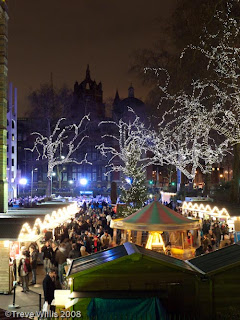
Shooting at high ISOs meant that one of the first things I did was to look at shadow areas at 100% to look for the noise, and sure enough there is luminance and chroma noise there. I am no expert at optimising Lightroom’s controls to get the best image with noise reduction turned on, but I found that using settings of 50 for luminance (L) and 25 for colour (C) noise reduction reduced the noise enough without making them unacceptably soft to produce good screen images and prints. In any case after the chroma noise is reduced by the default setting in Lightroom of 25 C the remaining luminance noise is not really objectionable, and certainly no worse than most film grain would have been at lower ISOs.
Below is a set of three 100% crops with no noise reduction, 0 L & 25 C and 50 L & 25 C respectively of a noisy area around the dome in the background from the 800 ISO image above, taken at 29mm, ¼ sec @ f5.6.
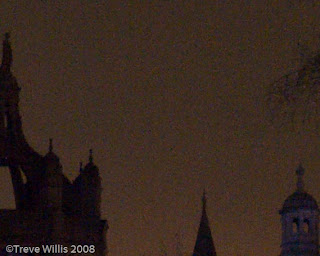

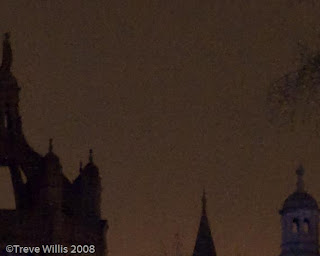
Below is another set of three 100% crops with no noise reduction, 0 L & 25 C and 50 L & 25 C respectively taken from a 1,250 ISO image taken at 14mm, 1/20th Sec @ f4.5
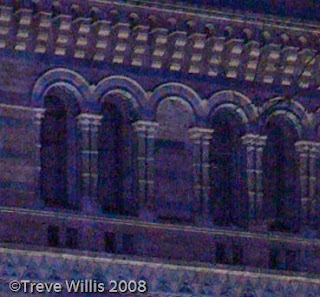

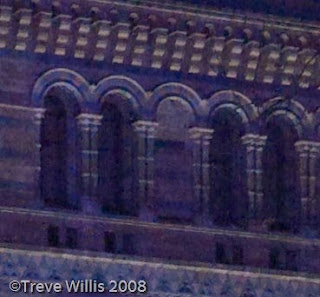
Subsequently I have taken images ranging in ISO from 100 to 1,250; mostly at wide open apertures, or one stop down.
The shot below was taken in the Covered Market in Oxford at 33mm, 1/40th Sec, f5.4, 400 ISO.

I also went out in a hard frost with grey skies and took a range of still life and semi-action photos of my cats prancing around the garden. When I downloaded the photos into Lightroom I was a bit surprised to see that they almost looked like B&W photos – the colours were very de-saturated and muted; but then so was the light. I experimented with close up shots – not using a tripod made it impossible to use much more than wide open apertures at the 45mm setting, and they were not brilliant. I was, however, quite happy with the detail I got when everything came together, but in general the images were soft. Not surprisingly the semi-action shots of my cats were not great, but when they sat still for a moment or two they came out nicely, although also suffering from very flat lighting.
I have printed a selection of images at A4/letter and A3 size on my Epson 4800 and I have to say that the response from friends and family is very gratifying – they love them.
Whatever noise I can see on screen at 100% pixel peeping is not an issue in print – even the high ISO prints at A3.
Apart from the noise most of the images, except for those taken in flat grey light, have been pretty good straight out of the camera and I have not tended to do much in Lightroom other than tweak the sharpening, noise and, when needed, the exposure.
14-45 lens and Image Stabilisation
I can not say how many extra stops the image stabilisation allows, but I was happy with the photos taken at ¼ sec (and resting on a railing for extra support) and in general I found that camera shake was not much of an issue. There was plenty of motion blur in many shots, but plenty of images with little evidence of camera shake. So my general conclusion is that the Image Stabilisation is working; I just can not estimate how much.
The lens itself performs pretty well – I do find its high maximum apertures a bit limiting and would like to try out faster fixed and zoom lenses when they become available to try to balance the “size and convenience” vs. “ease of use and image quality equation”.
Conclusion
I am very happy with the image quality I am seeing – this camera excels as a lightweight high quality walk around camera. Most of the best photos have been taken at high’ish ISOs and when I would not have wanted to have a better quality, but weightier and intrusive DSLR kit in tow.
While there is noise in the images Lightroom is able to deal with them quite easily – I have not had to resort to Noise Ninja yet, and they print up beautifully to at least A3.
At the moment I am thinking of the G1 as a keeper, best used for fairly slow paced available light scene and street photography.
I would certainly like to try out the 45-200mm lens if I can borrow or find one at a sensible price – the prices for them are much higher in the UK than the US; being about the same number of £s in the UK as $s in the US, nor are they widely available in the UK yet – and other lenses as they come on to the market. Read more...




6 comments:
Thank you for sharing your findings about the G1 whit others. I am going to buy one, with both lenses, and find any information usefull and also a interesting pastime. William Liefting, Holland
Hi
Glad to be a help - I have just bought the 45-200mm lens so will be posting my experience with it in the next couple of weeks.
I appreciate your site and comments. I just started working iwth the G1 and really like it. I am having a card error issue - and can't find remarks about it - namely I have a card in the camera which works fine, but the camera says there is no card in the camera...I tried reformating - no change. Any ideas?
Sorry - I have no idea. It is not a problem I have experienced.
It sounds very good. The most interesting thing for me is the possible use of manual focus lenses, via adapters already on the market. This will bring the cost down considerably, making high quality more available. It sounds very portable and with a 16mm cine or say hexanon pancake lens attached, very lightweight indeed.
I purchased a Lumix G1 last weekend and have been taking randomn test shots this week.
I do have some concerns about the pictures when shot using JPEG. The images are a little soft and not as well defined as I'm use to.
This does improve if using RAW, however I'm not a fan of Silkypics.
Has anyone else noticed the soft pictures using JPEG and is there anyway of improving them? I've managed to boost the sharpness levels to the max, but without much success.
Post a Comment